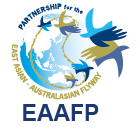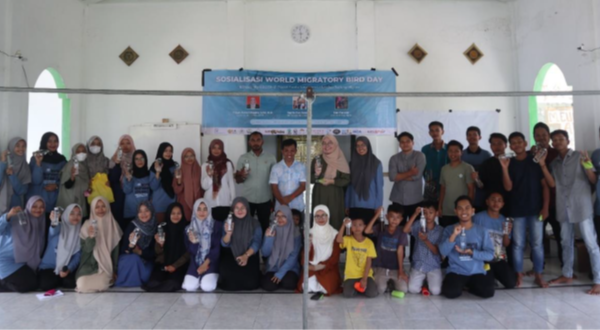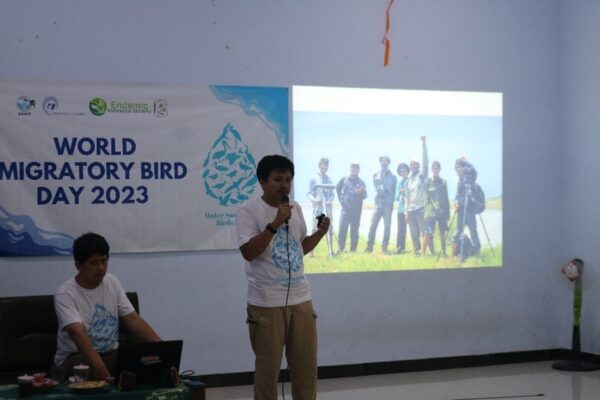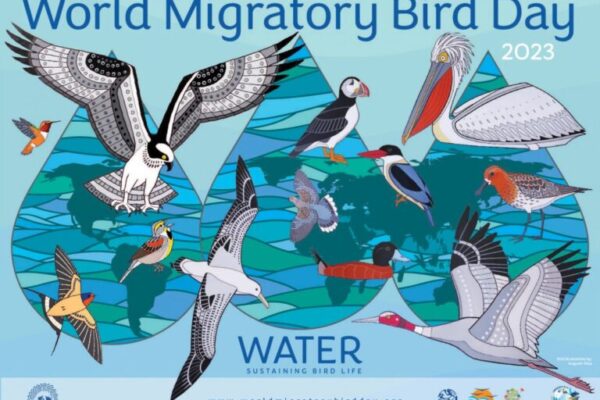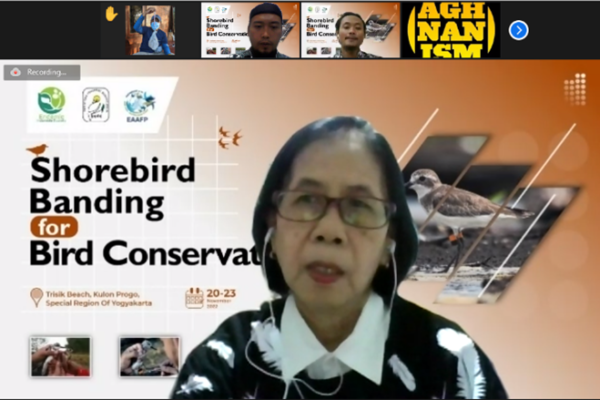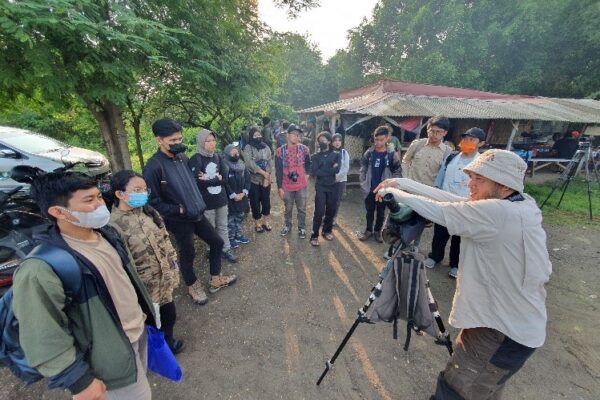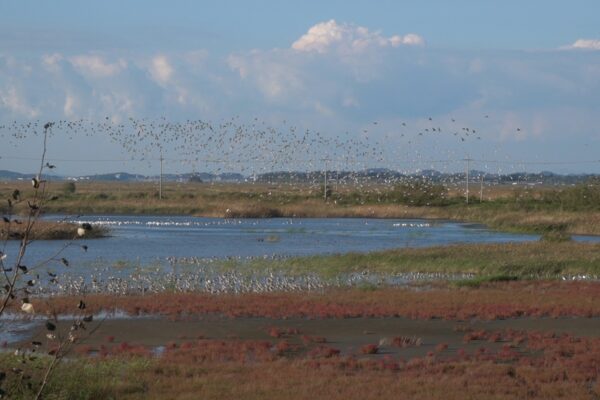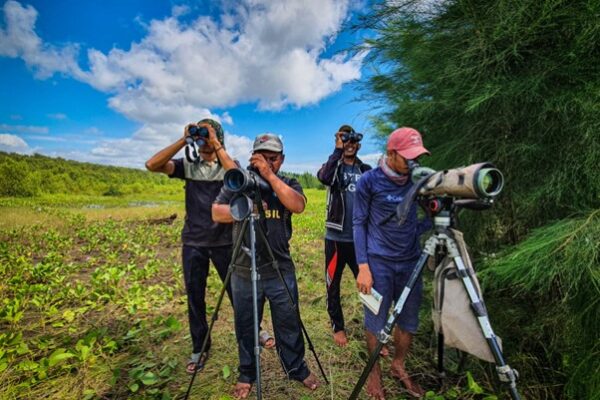-
World Migratory Bird Day 2023 Celebrated in Aceh, Indonesia, for students with special needs “Everyone Can Protect Birds”
World Migratory Bird Day (WMBD) 2023 was celebrated in Aceh, Indonesia with great enthusiasm and a series of engaging activities organized by the Pusat Riset Konservasi Gajah dan Biodiversitas Hutan (PKGB) at Syiah Kuala University. The aim of the event was to raise awareness and involve over 8-participants, including teachers, and students with special needs, in the conservation of migratory birds and their habitats. ©️ PKBG-USK The event kicked off with a seminar on 25th May 2023, with the theme "Water: Sustaining Bird Life." The seminar, held in collaboration with the Research Center for Elephant Conservation and Forest Biodiversity (PKGB) and the Pembina Aceh Province State SLB, featured two sessions. In the first session, Mrs. Maria Ulva, an expert in practicing children with special needs, introduced different bird species using hand puppets as visual aids. This method proved effective in engaging students with special needs and helping them understand and appreciate birds. ©️ PKBG-USK Dr. Abdullah, the head of the Research Center for Elephant Conservation and Forest Biodiversity, led the second session. He discussed small activities that individuals can undertake to protect the environment, such as avoiding smoking, littering, and consuming wild birds. The session also included an introduction to various migratory bird species found in Aceh Province through audiovisual presentations. One of the highlights of the celebration was the application of inclusive education methods. This approach aimed to provide equal educational opportunities to all students, including those with special needs, by incorporating migratory bird conservation materials into the curriculum. Teachers played a crucial role in adapting the learning materials and techniques to suit the needs of students with different limitations. The efforts resulted in an inclusive learning environment where all students could actively participate and understand the importance of bird conservation. ©️ PKBG-USK The event also featured a Migratory Bird Festival, during which students and parents received souvenirs and learning aids to support their education. Teachers and committee members who demonstrated exceptional skills in explaining the materials to students were also recognized with souvenirs. As a symbolic gesture, birds were released by the students and teachers to promote the idea of birds thriving in their natural habitats rather than being confined in cages. ©️ PKBG-USK The outcomes of the World Migratory Bird Day 2023 event were significant. Students with special needs gained knowledge about birds, conservation, and environmental preservation. Teachers were educated about the importance of preventing the consumption of wild birds and involving parents in ecosystem conservation efforts. The event fostered a sense of responsibility and appreciation for nature among the younger generation. ©️ PKBG-USK The Pusat Riset Konservasi Gajah dan Biodiversitas Hutan (PKGB) at Syiah Kuala University, along with their partners and sponsors, successfully organized a memorable World Migratory Bird Day celebration. The event showcased the power of inclusive education, creative teaching methods, and community involvement in raising awareness about migratory birds and their habitats. It left a lasting impact on the participants, empowering them to contribute to the conservation of our natural heritage. The project was funded through the 2023 EAAFP WMBD Small Grant Fund. View the report, Click here. Article prepared by Pusat Riset Konservasi Gajah dan Biodiversitas Hutan, Syiah Kuala University
Continue reading -
Aceh Bird Club Celebrates World Migratory Bird Day 2023 with Engaging Activities to Keep Water from Plastic Waste in Indonesia
The Aceh Bird Club, in collaboration with the Biology Education Student Association (HIMABIO) at Syiah Kuala University, Ache, Indonesia, recently organized a remarkable series of events to celebrate World Migratory Bird Day 2023. The week-long event, held from 14th to 21st May 2023, aimed to raise awareness about the importance of protecting the environment, migratory birds, and their habitats. With the active participation of students, university students, environmentalists, communities, lecturers, and several related agencies, the event was a resounding success. © Aceh Bird Club The festivities commenced with three engaging competitions: a short video competition, a photography competition, and an essay-writing competition. Open to participants of all ages, these competitions served as platforms to educate the younger generation about the detrimental impact of microplastics on water and its consequences for both humans and migratory birds. The competitions were conducted online, allowing contestants to submit their entries through an online form provided by the committee. A total of 30 contestants participated, showcasing their talent and commitment to environmental conservation. © Aceh Bird Club The winners of the photography competition captured stunning images that conveyed the theme, "Save Water for the Future of Migratory Birds and Humans." Muhammad Al Fatih from UNS clinched the 1st position with his captivating photograph titled "Milik Bersama" (Shared Ownership). Hudzaifah Fahroni from UNJ secured the 2nd position with his compelling image titled "Pengunjung tetap teluk Jakarta" (Visitors of Jakarta Bay), while Haris Akbar Hidayat from IPB won the 3rd position with his evocative photograph titled "Berbagi Ruang" (Sharing Space). Click [here] to see the winning photos! © Aceh Bird Club In the short video competition, Muslim, Gansar, and M. Akbar, all from Syiah Kuala University, emerged as the top three winners. Their videos conveyed powerful messages about the importance of protecting water for migratory birds and the future of humanity. Click [here] to see the winning short videos! © Aceh Bird Club Furthermore, the essay writing competition challenged students to think critically and propose innovative ideas on the topic "Utilization of Technology for Monitoring Waste and Microplastics." Imam Safir Alwan Nurza from UNJ won the 1st position with his essay titled "Decase U-Bot", followed by I Made Egga Adika Saputra from Denpasar in 2nd place and Presty Wulandari from Gorontalo State University in 3rd place. Click [here] to see the winning essays! © Aceh Bird Club The pinnacle of the event was the campaign held at the Peulanggahan village hall in Banda Aceh on 20th May 2023. The campaign featured two expert presenters, Fitrah Asma Ulhusna and Heri Tarmizi, who enlightened the 50 participants about the types and dangers of microplastics to both residents and migratory birds. The event also included interactive sessions, distribution of educational materials, souvenirs, and prizes to recognize outstanding participants. The event concluded with a cleanup activity along the river in the Lampulo area of Banda Aceh on 21st May. Attended by 70 participants, including students, university students, environmentalists, and the local community, this initiative aimed to create awareness about waste disposal and environmental preservation. The activity received extensive media coverage and inspired individuals to protect the environment and dispose of waste responsibly. © Aceh Bird Club © Aceh Bird Club The Aceh Bird Club's celebration of World Migratory Bird Day 2023 successfully fostered environmental consciousness among participants of all ages. By combining competitions, campaigns, and community engagement, the event highlighted the significance of preserving our ecosystems for the benefit of migratory birds and humanity. © Aceh Bird Club The project was funded through the 2023 EAAFP WMBD Small Grant Fund. View the report, Click here. View the event photos on the Flickr Album [here]. Article prepared by Aceh Bird Club
Continue reading -
World Migratory Bird Day 2023 in Yogyakarta, Indonesia: Fostering Awareness for Water and Bird Conservation
World Migratory Bird Day 2023 © Endemic Indonesia Society The World Migratory Bird Day (WMBD) 2023 was celebrated with great enthusiasm and success in Yogyakarta, Indonesia. The event, organized by the Endemic Indonesia Society, aimed to raise awareness about the importance of water for both birds and people, particularly focusing on the conservation of migratory birds in the Progo River Estuary. R. Arif Alfauzi, S.Si delivering his presentation © Endemic Indonesia Society The activities commenced with a school visit to the local school MTs Darul Ulum Galur Kulon Progo on 13th May, 2023. R. Arif Alfauzi, S.Si., an experienced alumnus of UNY(Universitas Negeri Yogyakarta), delivered a presentation on the conservation of migratory birds in the Progo River estuary. Approximately 38 students, 4 teachers, and 10 university students attended the session, gaining valuable insights into the significance of preserving bird habitats. Birdwatching activity at the Progo River estuary © Endemic Indonesia Society Later in the day, birdwatching activities took place near the Progo River estuary in Bantul. Students from MTs Darul Ulum and around 20 university students participated in this event, guided by members of the Yogyakarta Birdwatchers Society. Divided into groups, the participants had the opportunity to observe and identify various bird species. Despite not being the migration season, they were still able to spot species such as the Common Sandpiper, Javan Plover, and Greater Crested Tern. The presence of journalists during the event led to a media article, further spreading awareness about the conservation efforts. To engage a broader audience, an online photo and article competition was conducted from 11th to 24th May, 2023. Divided into two categories, students and university students, the competition received approximately 30 entries. The submitted works were evaluated, and the winners were announced during the concluding webinar on 27th May. Winner of the photo competition (student division) © Endemic Indonesia Society Winner of the photo competition (university division) © Endemic Indonesia Society Webinar about water and bird conservation in the Progo River © Endemic Indonesia Society The webinar served as the highlight of the WMBD 2023 event. With a theme focused on water and bird conservation in the Progo River, the webinar attracted approximately 80 participants from various backgrounds, where they shared research findings on the dangers of microplastics in the Progo River flow. Throughout the series of activities, the Endemic Indonesia Society recognized the importance of involving the media to raise awareness about migratory bird conservation. It further spread the message beyond the event's immediate participants. Birds found in the Progo River estuary © Endemic Indonesia Society The Progo River estuary holds great significance as a water source for surrounding communities and as a crucial feeding and resting place for migratory birds. The presence of endangered species at the site such as the Great Knot, Nordmann's Greenshank, and Far-eastern Curlew highlights the importance of conservation efforts. However, these birds face numerous threats, including hunting, habitat degradation, and the presence of microplastics in the river flow. The WMBD 2023 activities successfully highlighted these issues and fostered greater awareness and understanding among participants, contributing to the ongoing conservation efforts in Yogyakarta. By organizing educational initiatives and engaging with schools, communities, and decision-makers, the Endemic Indonesia Society and its partners took significant steps toward protecting migratory birds and their habitats. The success of the WMBD 2023 event not only underscored the importance of water for birds and people but also emphasized the need for continued collaboration and action to ensure the long-term survival of these remarkable migratory species in the Progo River estuary. News article 1: EIS and MTS Darul Ulum Kulonprogo Conduct Bird Watching in Muara Progo News article 2: Kali Progo is polluted by microplastics due to trash from baby diapers to mattresses News article 3: Massive sand mining at the mouth of the Progo River threatens the habitat of migratory shorebirds The project was funded through the 2023 EAAFP WMBD Small Grant Fund. View the report, Click here. Article prepared by Endemic Indonesia Society.
Continue reading -
World Migratory Bird Day 2023 highlights impact of the growing water crisis on migratory birds
BOULDER/BONN/INCHEON, 13 May 2023 – Water and its importance to migratory birds – and the increasing threats to both water quality and quantity - is the focus of this year’s World Migratory Bird Day, a global campaign that aims to raise awareness of migratory birds and the need for international cooperation to conserve them. Activities to mark the campaign will be held globally on two peak days in May and October under the theme “Water: Sustaining Bird Life” Water is fundamental to sustaining life on our planet. Migratory birds rely on water and its associated habitats—lakes, rivers, streams, ponds, swamps, marshes, and coastal wetlands—for breeding, resting, refueling during migration, and wintering. Yet increasing human demand for water, along with climate change, pollution, and other factors, are threatening these precious aquatic ecosystems. Headlines around the world are sounding alarm: 35 percent of the world’s wetlands, critical to migratory birds, have been lost in the last 50 years. Utah’s Great Salt Lake, the largest saltwater lake in the Western Hemisphere and used by more than a million shorebirds, is in danger of disappearing within five years. Across the Amur-Heilong Basin in Asia, climate change is amplifying the impact of habitat destruction by depleting natural water systems and depriving migratory birds of vital breeding and stopover site. These sobering examples go hand-in-hand with recent reports that reveal that 48 percent of bird species worldwide are undergoing population declines. Another poignant example is that of the Aral Sea shared by Kazakhstan and Uzbekistan. Once the fourth-largest lake in the world, it is widely regarded as one of the planet’s worst water-related environmental disasters. Soviet-era irrigation projects almost completely dried up the lake, which led to the loss of livelihoods for fishermen and farmers and the deterioration of public health due to toxic dust and reduced access to clean water. The impact has been severe for the communities around the lake, but also for migratory birds, which lost important food sources and a critically important stopover point on their journey. Another example is the Sahel, a vast semi-arid region in Africa: Prolonged periods of drought, deforestation, and overgrazing in the Sahel have led to the degradation of the soil and loss of vegetation, threatening the survival of both the local human population and wildlife, including migratory birds. Lake Chad, one of the largest water bodies in Africa in 1960, lost 90 % of its area, depleting water resources for local communities and also for many migratory birds. World Migratory Bird Day serves as an international call to action for the protection of migratory birds, whose ranges often span multiple countries, and are facing many different threats worldwide. The annual campaign is organized by the Convention on the Conservation of Migratory Species of Wild Animals (CMS), the African-Eurasian Migratory Waterbird Agreement (AEWA), Environment for the Americas (EFTA), and the East Asian-Australasian Flyway Partnership (EAAFP). World Migratory Bird Day 2023 will be officially held on 13 May and 14 October. The two days of World Migratory Bird Day reflect the cyclical nature of bird migration as well as the fact that there are varying peak migration periods in the northern and southern hemispheres. Events to raise awareness of migratory birds and the importance of water will take place all over the world including in local parks, nature centers, museums, libraries, schools, and other locations on these peak days and throughout the year. To learn more about this year’s World Migratory Bird Day campaign and actions to take, visit www.worldmigratorybirdday.org and EAAFP WMBD 2023 webpage: https://www.eaaflyway.net/world-migratory-bird-day-2023/ Also, please have a look of the Campaign Strategy for promoting World Migratory Bird Day, click [here]. For more resources, visit the Trello Board [here]. Message from the Partners of World Migratory Bird Day Convention on Migratory Species (CMS) “Water is essential for people as well as for migratory birds and other wild species of animals. Yet around the world, the availability and quality of water is under enormous pressure, with deeply concerning implications. The looming global water crisis requires urgent action by governments, businesses, local communities as well as individuals. Because migratory birds cross national borders and even continents, international cooperation is essential to ensure that actions are taken to conserve and restore important habitat for migratory birds, and to address the drivers of water loss, pollution, and climate change,” said Amy Fraenkel, Executive Secretary of the Convention on the Conservation of Migratory Species of Wild Animals (CMS). African-Eurasian Migratory Waterbird Agreement (AEWA) “The water crisis recently highlighted by the UN 2023 Water Conference also has a tremendous impact on migratory birds. In the Sahel in particular, many wetlands on which migratory waterbirds rely during the non-breeding period are shrinking. Water is a vital resource for all, local communities as well as birds. By reducing our consumption, combatting climate change, and managing wetlands wiser, we can improve the situation,” said Dr. Jacques Trouvilliez, Executive Secretary of the Agreement on the Conservation of African-Eurasian Migratory Waterbirds (AEWA). Environment for the Americas (EFTA) “World Migratory Bird Day 2023 spotlights the vital role that water plays in the survival of our shared birds. The focal species illustrated on the campaign poster depict the intricate bond each bird shares with water. The diminutive Rufous Hummingbird thrives on nectar-producing flowers that rely on water for their blooms, and the Dickcissel scours the grasslands for seeds that hold the moisture they need. White Pelicans and Ospreys seek their prey in freshwater lakes, while the magnificent Wandering Albatross and Atlantic Puffin remain at sea. WMBD is an opportunity to unify our voices for the conservation of migratory birds and to celebrate their spectacular journeys,” said Dr. Susan Bonfield, Executive Director at Environment for the Americas (EFTA). East Asian-Australasian Flyway Partnership (EAAFP) “This year's WMBD theme serves as a vital reminder of the linkage of migratory birds to the importance of protecting aquatic ecosystems and conserving wetlands. As birds such as threatened Spoon-billed Sandpiper, Dalmatian Pelican, and Sarus Crane migrate, they rely heavily on wetlands for survival. We must take urgent actions and collaborate at all levels, from citizens to among governments, to tackle the problems of saving water and aquatic ecosystem, and ensure that migratory birds continue to thrive.” Ms. Yeounhee Ahn, Deputy Executive of East Asian-Australasian Flyway Partnership (EAAFP).
Continue reading -
Seminar and Training on Shorebird Banding for Bird Conservationists at Trisik Beach, Kulon Progo, Special Region of Yogyakarta, Indonesia
2022 EAAFP Small Grant Fund Project by Ahmad Zulfikar Abdullah Endemic Indonesia Society Mist net installation practice © Endemic Indonesia Society Birdbanding is a technique used to study wild birds which had been applied internationally in numerous researches and requires a distinct set of skills and expertise, including equipment use, bird safety, and alertness during the entire process. Bird banding has been a regular activity in Indonesia since the 1950s, and is supervised by the Indonesian Bird Banding Scheme (IBBS). Since 2010, bird banding groups have emerged from different cities including Bogor, Yogyakarta, and Surabaya. However, the majority of these groups have failed to maintain a consistent program for the past few years, which resulted in the absence of new bird banding activists. This is shown by the stagnant number of licensed bird bander in Indonesia. With support from the EAAFP Small Grant Fund for Working Groups and Task Forces, Endemic Indonesia Society organized a bird banding-focused event through seminars and training. This event, which was held on November 19-23, 2022, has been conducted in Yogyakarta due to its ease of access and could involve the active bird banding community, Jogja Birdbanding Club. We believe that reintroducing bird banding through seminars and hands-on workshops to bird conservation activists, especially the younger age group, is urgently needed to ensure the continuity of bird banding scheme in Indonesia as well as keeping information on bird migration updated. Seminar The first plan for the seminar, which was held offline, was changed to online in order to reach more participants. This seminar has presented speakers from ornithology experts, especially those related to bird banding and wetlands. Participants who attended the event came from various backgrounds such as bird researchers, bird watchers, university students, local NGOs, government staff especially in the environment sector, and the local community. Presented seminar topics including : National and Global Perspective of Bird Banding Speaker: Prof. Dr. Dewi Malia Prawiradilaga, MSc., PhD. (National Research and Innovation Agency; Indonesian Bird Banding Scheme) Bird Banding Techniques & Application in Research Speaker: Ign. Pramana Yuda, Ph.D. (Lecture of Atma Jaya Yogyakarta University; President of Indonesian Ornithologists Union) Wetlands and Migratory Bird Conservation Speaker : Ragil Satriyo Gumilang, S.Hut., M.Si. (Wetlands International Indonesia) Goverment’s Role in Migratory Bird Conservation in Trisik Beach Speaker: Tri Dibyo Sumbogo (Natural Resources Conservation Agency of Yogyakarta) First Speaker Second Speaker Third Speaker Fourth Speaker The seminar that was held one day before the training went successfully. Discussions during the seminar showed that the topics presented by the speakers were well understood by the participants. From this seminar, it can be concluded that wetland conservation is generally known by the public, but it's the exact opposite in bird banding. It needs to be collaborative activities that involve many stakeholders if we want to apply this method to support bird and habitat conservation programs. Training The training was attended by 20 participants who had registered and been selected. This activity was assisted by trainers and assistants who have bird banding licenses issued by the Indonesian Bird Banding Scheme. The main trainer was Iwan Febrianto from the Yayasan Ekologi Satwa Liar Indonesia. Participants came from various backgrounds such as students, lecturers, NGO activists, bird watchers, and veterinarians. These activities were divided into two stages. The first stage was conducted twice, in July and September, with passerine birds as the target. This stage aimed to introduce and familiarise the participants with bird banding techniques. Some of the birds that were successfully tagged including: Actitis hypoleucos, Alophoixus bres, Arachnothera longirostra, Cinnyris ornatus, Halcyon cyanoventris, Lonchura leucogastroides, Orthotomus sutorius, Passer montanus, Pellorneum capistratum. Bird banding in July Introduce mist net installation Bird tagging Halcyon cyanoventris Bird banding in September Bird measurements Actitis hypoleucos Orthotomus sutorius The second stage, training with shorebird targets, was conducted in November in Trisik beach area and Progo River estuary. Both locations become an ideal location for our training program due to its easy access and long history of shorebird records. Briefing for participants Mist net installation practice Mist net installation practice Mist net installation practice During the four days of training, it was raining almost every evening and night with strong winds. This condition causes the installation of nets to become not optimal considering that shorebird banding is ideally carried out at night. The training was maximized in the morning and afternoon by targeting birds in the location, which were mostly passerine birds. Some of the birds that were successfully tagged including: Alcedo coerulescens, Anthreptes malacensis, Cisticola juncidis, Geopelia striata, Lonchura leucogastroides, Lonchura punctulata, Orthotomus sutorius, Passer montanus, Prinia inornata, Turnix suscitator. Calidris alba Calidris melanotos Phalaropus fulicaria Philomachus pugnax The conclusion from these events is that there are needs to be encouragement in the form of continuous activities to optimize the use of this method, in order to support bird and habitat conservation efforts. The project was funded through the 2022 EAAFP WG/TF Small Grant Fund. View the report, Click here.
Continue reading -
Not a Threat: How Vegetation Expansion affecting the pattern of Habitat Used by Migratory Waterbirds at Pantai Cemara, Jambi
EAAFP Small Grant Fund Project by Cipto Dwi Handono EKSAI Foundation Spotted Greenshank (Tringa guttifer) recorded at Pantai Cemara, Jambi during this research (November 2021) © Cipto Dwi Handono In 2021 EKSAI Foundation received a small grant fund from the EAAFP to evaluate the potential threat of vegetation expansion on the mudflat of Pantai Cemara, Jambi. From the monitoring in 2020, EKSAI Foundation recorded a massive growth of Ipomoea sp., that later identified as Ipomoea pes-carpae together with a decrease of migratory waterbirds number at Pantai Cemara, Jambi. From 4 days of monitoring and vegetation analysis at Pantai Cemara, Jambi, EKSAI Foundation recorded 35 species of migratory waterbirds and a maximum count of 3.445 birds at Pantai Cemara, Jambi. This result shows a stable number from 2020 which recorded 2.836 birds from 30 species. EKSAI Foundation also recorded two new species that had never been recorded at Pantai Cemara before: Lesser Crested Tern and Broad-billed Sandpiper. Vegetation analysis done by EKSAI Foundation shows that all of the vegetation on site are native species: Ipomoea pes-carpae (the most dominant species on mudflat), Sea-pine, and Avicennia sp. Ipomoea pes-carpae was recorded as invasive in three countries: Spain, Anguilla, and South Africa (Dana, et al., 2020; Connor et al., 2021; and Foxcroft et al., 2020), hence, the result from this monitoring can not prove that ipomoea pes-carpae are invasive and threat the migratory waterbirds community at Pantai Cemara, Jambi. Despite that result, EKSAI Foundation notices that vegetation growth still affects the birds, especially in migratory waterbirds' habitat use and selection. In fig. 01 : (1), (2), and (3) we can compare the mudflat area used by migratory waterbirds at Pantai Cemara, Jambi in 2019, 2020, and 2021. Fig 01. (1) Vegetation and migratory waterbird in 2019 Fig 01. (2) Vegetation and migratory waterbird in 2020 Fig 01. (3) Vegetation and migratory waterbird in 2021 From fig 01, we can see that the migratory waterbird flocks are shifting following the vegetation growth to find the remaining open mudflat at Pantai Cemara, Jambi. Together with the vegetation growth, the team of EKSAI Foundation found a new-form mudflat that was used by migratory waterbirds flock in 2021. This new-form mudflat is formed on the southeast side of Pantai Cemara. We need to continuously survey to monitor the vegetation and mudflat at Pantai Cemara, so we can understand the pattern of migratory waterbirds' habitat at Pantai Cemara. This information is very valuable for migratory waterbirds’ habitat management. Conclusion The expansion of vegetation especially Ipomoea pes-carpae growth at Pantai Cemara Jambi does not identify as a threat to migratory waterbirds, yet still affects the area used by migratory waterbird flocks at Pantai Cemara, Jambi. Based on the interview with local people, a large land clearing near Desa Cemara might cause the increase of organic waste in the river and estuary that possibly be a cause of the increase of vegetation growth at Pantai Cemara, Jambi. During this research, we identify 35 species of migratory waterbirds with a maximum count of total migratory waterbirds is 3.445. This result shows that the migratory waterbirds number from 2020 to 2021 is stable and tends to increase through the vegetation is still growing intensively. The result from this research does not show that the vegetation growth threatened the migratory waterbirds community, but still affects the area used by migratory waterbirds due to the mudflats covered by Ipomoea pes-caprae and other vegetation at Pantai Cemara. The local government and local agencies responsible for the management of Pantai Cemara are committed to proposing this area to be a new Flyway Network Site in Indonesia in 2022, our team will help and follow up this commitment and help to compile the SIS together with all the responsible authorities. The project was funded through the 2021 EAAFP WG/TF Small Grant Fund. View the report, Click here. For inquiries, contact Cipto Dwi Handono at ciptodwihandono@gmail.com
Continue reading -
Skilled Stakeholder Meets Technology: The Next Step of Migratory Waterbirds Conservation in Indonesia
EAAFP Small Grant Fund Project by Ragil Rihadini Yayasan Ekologi Satwa Alam Liar Indonesia (EKSAI Foundation) Indonesia, is one of the important wintering habitats for migratory waterbirds. With a total of 19.181 km shoreline (KKP, 2019), the information about migratory waterbirds in Indonesia is still little. Most records and information cantered in Java and Sumatra Island, this caused threats on the unknown potential sites (fig.01). Fig.01. Shorebirds Data (in red) from 2016-2022; source: burungnesia app. Many migratory waterbirds' important sites in Indonesia are not protected yet, some other are predicted as important sites but it needs more data and information to confirm that. Unfortunately, some of those areas do not have any birdwatchers who skilled in shorebirds identification. Meanwhile, threats such as hunting, habitat change, and other human disturbance frequently recorded in Indonesia; as the local people rarely understand the importance of conserving the waterbirds. As from our survey before proposing this project to the EAAFP, more than 60% of local birdwatchers are not familiar with waterbirds, and more than 70% are not familiar with migration and shorebirds. This makes us hard to access information about migratory shorebirds in Indonesia, and several times during our survey on new sites, we will find people hunting for waterbirds, simply because they did not know what is that, and how important it is to conserve the birds. The need for skilled birdwatchers as conservation agents: citizen scientists, bird researchers, college students, and government agencies to do regular and systematic surveys on the nearest potential habitat of migratory waterbirds. Fig.02. Field Training of Local Stakeholders in Indonesia Need of coordinated monitoring; cantered data (waterbirds database) that will help the scientists and management coordinator to determine the suitable action for shorebird conservation base on that data and information. With no coordinated monitoring and hunting assessment for migratory waterbird conservation, it will be hard to control threats and protect the birds (Eduardo et al, 2020). Fig.03 (a) the illustration of burungnesia.app (b) the data of Nordmann Greenshank in Indonesia from burungnesia app With support from the East Asia Australasia Flyway Partnership (EAAFP), we were able to combine conservation action and technology through a conservation training activity in Indonesia last November – December, 2022. The small grant from the EAAFP makes us able to reach and develop the shorebirds conservation skills and knowledge of at least 30 of local stakeholders from all around Indonesia (from Papua to Sumatra); covers the government agencies, national parks’ agents, college students, birdwatchers, and local NGOs representative. They got several materials about migratory waterbird conservation during the training: creating a community and research-based conservation program; shorebirds habitat management; shorebirds identification, etc. They also got access to discussing their on-field problems with experts during and after the training. In the process to creating a coordinated monitoring and shorebirds database in Indonesia, we collaborate with our partners in Burungnesia.app; an android application for submitting birds checklists. All the trained participants are mandatory to install and register in Burungnesia.app; they also train on how to submit and using this app. By combining the skilled stakeholders and this technology we hope the data, information, and study about migratory shorebirds in Indonesia will increase, also the conservation action and protection of shorebirds in Indonesia will become a serious attention. The project was funded through the 2022 EAAFP WG/TF Small Grant Fund. View the report, Click here.
Continue reading -
Activities of the EAAFP Secretariat for Hwaseong Wetlands Conservation Projects 2020-2022
The scenery of the Hwaseong Wetlands Flyway Network Site © EAAFP Secretariat In November 2018, Hwaseong Wetlands was nominated as the East Asian-Australasian Flyway Network Site (FNS) as its importance as a habitat for migratory waterbirds has been acknowledged. With its designation, Hwaseong City and the EAAFP Secretariat signed an MOU [article] and proceeded with the project called “Collaboration for Conservation of the Hwaseong Wetlands” for three consecutive years, from 2020 to 2022. This article demonstrates the project activities that were carried out in chronological order. <2020> The Project was carried out in six major activities. EAAFP, Birds Korea, Federation for Environmental Movements of Hwaseong (KFEM Hwaseong), Korea Federation for Environmental Movements (KFEM), and Hwaseong City together prepared for the event from June, proceeding with the international symposium online in December 2020. About 300 concurrent users with 2400 views participated and discussed the management of Hwaseong Wetlands together with citizens, farmers, fishermen, the Rural Community Corporation, the Ministry of Oceans and Fisheries, the Ministry of Environment, researchers, international organizations, and overseas experts. Article: Link Follow-up Actions to the Symposium: Production of Guidelines for Hwaseong Wetland Management Plan and Workshops. Based on discussions on the management of Hwaseong Wetlands at the symposium in December 2020, the EAAFP Secretariat presented guidelines for Hwaseong Wetland Management Plan after two workshops and one advisory meeting in February and March 2021. Hwaseong City, Hwaseong Eco Foundation, and the Symposium Task Force team (the EAAFP Secretariat, KFEM, KFEM Hwaseong, and Birds Korea) participated in the workshop to reach an agreement on the direction of Hwaseong Wetland management in 2021 and beyond. The title of the guideline is ‘The Proposal for the Management Directions for the Sustainable use of the Hwaseong Wetlands’ and was referred to domestic and international wetland management plans and management guidelines. This suggestion presents the scope of management, direction of wetland management, partnership establishment, and setting of goals and implementations. It also proposes to form a consultative body when establishing a partnership, to have an implementation organization accordingly, and to entrust it to civic groups, which has not been attempted in Korea. The authors of the guidelines are Ms. Yeonah Ku (EAAFP Secretariat), (KFEM Hwaseong), and Ms. Hyeseon Do (EAAFP Secretariat), members of the Symposium TF. The external manuscript of Han Donguk, the Director of the PGA Wetland Ecology Research Institute, was also included. Article: Link Hwaseong Wetlands Conservation Resident Project The resident project organized by HEFM initially considered the formation of a symposium preparatory committee, but because of the rising number of COVID-19 cases, it was more carried out as an awareness-raising-oriented activity. From July 2020 to March 2021, six meetings, seven campaigns, eight club activities, two discussions, three lectures, five civic ecological research group activities, and one ecological exploration activity were held. Article: Link International Cooperation Project for the Conservation of Far Eastern Curlew The EAAFP Secretariat discussed with EAAFP Far Eastern Curlew Task Force and decided to support the “Far Eastern Curlew Conservation Project in Sumatra Island” and funded the EKSAI Foundation in Indonesia. Through this research, a full investigation of Far Eastern Curlew and waterbirds in northern Sumatra including Sembilang National Park (South Sumatra Province), Pantai Cemara (Jambi Province) and Bagan Serdang (North Sumatra Province) was made, and training was conducted to local guards. Moreover, a report that compares and analyzes with waterbirds data has been written, which is uploaded on the EAAFP website. Article: Link Waterbird-oriented Ecological Survey and Far Eastern Curlew Network Construction Project Organized by Birds Korea and KFEM, ecological surveys at the Hwaseong Wetlands were carried out from June 2020 to March 2021. Through the survey, migration behavior and habitat of migratory waterbirds and their juvenile were identified. Based on the findings, guideline directions were proposed, and the Far Eastern Curlew Network was formed in December 2020. Among the findings, a report written in 2020 is uploaded on the EAAFP website. Related article 1: “Flyway: connecting people and migratory waterbirds” story series #6– Interview with Dr. Nial Moores Related article 2: The Hwaseong Wetlands Project Related article 3: The Launch of Far Eastern Curlew Network of the Korean Peninsula Promotional and Educational Materials Production Project The EAAFP Secretariat produced key species factsheets for public-raise awareness purposes in the East-Asian Australasian Flyway. The nine species were produced in both Korean and English. Article: Link Moreover, EAAFP Secretariat operated Hwaseong Wetlands FNS Facebook from July 2020 and is promoting Hwaseong Wetlands conservation activities. Article: Link Furthermore, prizes for the Hwaseong Wetland Promotion Contest winner were delivered. [Prize-winner] <2021> The Project was carried out in four major activities. International Cooperation Project for the Conservation of Far Eastern Curlew Following the previous activity of the Far Eastern Curlew surveys in Sumatra in Indonesia, the EKSAI Foundation took another series of surveys as well as training local communities in Sumatra. See the results and the reports in the separate article: Link Local Cooperation Project: Far Eastern Curlew Network in the Korean Peninsula Following the suggestion from the EAAFP Secretariat and Birds Korea in 2020 based on the ecological survey in the Hwaseong Wetlands Flyway Network Site (FNS) in 2020 and existing data from the National Institute of Biological Resources (NIBR), three local governments in ROK, Hwaseong City, Seocheon County, Yeonsu District of Incheon City, initiated the Far Eastern Curlew Network in the Korean Peninsula since 1st December 2020. As a secretariat of the network, Hwaseong City supported the Far Eastern Curlew survey held in July 2021, following the advice of Birds Korea and the EAAFP Secretariat. From July 21st to 25th 2021, 26 survey participants counted Far Eastern Curlews and other species at 34 sites in three areas: parts of coastal Incheon (Ganghwa Island, Yeongjong Island and Songdo, the Han Estuary); the adjacent Gyeonggi Coast (the Hwaseong Wetlands and Asan Bay); and the Geum Estuary (Figure 1). Participants are experienced counters with specialist knowledge of their areas. A total of 9,642 Far Eastern Curlews were recorded with 3,746 in Incheon; 3,255 in parts of Gyeonggi mainland coast; and 2,641 in Geum Estuary. This is around a third of the world’s population of the species, which was estimated to be 32,000 individuals (range: 20,000 – 49,000 individuals, source: https://www.iucnredlist.org/) Article: Link Local Residents Support Project: Citizen Ecological Survey, Marine Waste Cleaning, Civic Forum, and Walking Event To promote the importance of the Hwaseong Wetlands and to conserve wetlands in the hands of the local people, the EAAFP Secretariat and the Korean Federation of Environmental Movement–Hwaseong (KFEM Hwaseong) implemented the Local Residents Project for Conservation of the Hwaseong Wetlands from April to December 2021. Through the Project a citizen-based ecological survey group was formed, and ecological surveys and on-site monitoring activities were conducted with the guide led by experts in waterbirds, large benthos, wild animals, and amphibians. The Youth at Durae Natural High School near the Hwaseong Wetlands and instructors working in the region formed a small group (Dingo Club) together and conducted 5 times of indoor and field education activities regarding the Hwseong Wetlands. The students participated in the “Hwaseong Youth Policy Proposal Contest” and proposed policies for establishing the “Hwaseong Wetland Education Center” and won the Excellence Award. A local birdwatching and marine waste cleaning events were also held for the local citizens, providing sufficient education regarding marine waste problems and the importance of waterbirds. Furthermore, A civic forum was held with wetland NGOs, experts, and residents, titled ‘Benefits of the Hwaseong Wetlands, Shared with Together.’ Through the Forum, it was an opportunity to resolve conflicts over wetland development & conservation, seek new directions for reclaimed land in the Hwaseong Wetlands, and emphasize the importance of the Hwaseong Wetlands in and outside Hwaseong City. Lastly, Hwaseong Wetland Citizens’ Walking Event: Life and Peace Road was organized in solidarity with 17 civil society organizations in Suwon and Hwaseong Cities. Walking along the 5km section of the Hwaseong seawall, citizens toured the Hwaseong Wetlands, where numerous lives are alive and breathing, and shared the meaning of peace by listening to the story of the village suffering from 54 years of combat airfield at Maehyang-ri History Hall. Article: Link 2021 International Symposium for the Hwaseong Wetlands – “All Connected through the Hwaseong Wetlands: One World, One Future” On 26th November, the 2021 International Symposium for the Hwaseong Wetlands hosted by Hwaseong City took place at Purmir Hotel, Hwaseong City. Hwaseong Eco Foundation, EAAFP Secretariat, Birds Korea, and Korea Federation for Environmental Movements (KFEM) of Hwaseong co-organized the event, with support from the Ministry of Environment Ministry of Oceans and Fisheries, Cultural Heritage Administration of the Republic of Korea, and Hanns Seidel Foundation Korea. Based on the ideas drawn from the forum, the speakers raised the management and restoration plan on Tidal Flats in ROK with a policy proposal and discussed how to join force for the UNESCO World Natural Heritage Site Phase II. In addition, international experts presented the importance of designating the inland wetlands along the Hwaseong Lake as a Wetland Protected Area and the future management guidelines of the Hwaseong Wetlands with moderation by, Ms. Choony Kim, Secretary General of KFEM. During the panel discussion, the panelists emphasized the importance of designating the inland wetlands along the Hwaseong Lake as a Wetland Protected Area and the future management guideline of the Hwaseong Wetlands. Article: Link Symposium Video Links: Korean, English <2022> The Project was carried out in four major activities. International Cooperation Project for the Conservation of Far Eastern Curlew & domestic cooperation The afterwork has been conducted for the Far Eastern Curlew Conservation Project in Sumatra, Indonesia from January and February. The report document was revised according to the updated information provided by the EKSAI Foundation, the leading organization of the Fare Eastern Curlew Conservation Project in Sumatra. FEC Survey has been conducted in the Philippines from October to December 2022. The surveys were conducted in Bulacan, Malolos City, Pamarawan; National Capital region, Navotas City, Tansa; Cebu, Mandaue City; Negros Island, Negros Occidental; Iloilo City, Iloilo Province; Masbate State, Bicol Region; Oriental Mindoro; and La Union. With this survey there was an opportunity to introduce potentially important habitats for FEC in the Philippines and share survey data. It was reported that further support is required for the continuous implementation of the survey. In the other hand, the Secretariat supported the Hwaeong Eco Foundation and Hwaseong City by holding several meetings/ participating in several education trainings as a domestic cooperation activity. Hwaseong Wetlands Visioning Project In consultation with Wildfowl and Wetlands Trust (WWT) Based in UK, Hwaseong City and the EAAFP Secretariat have discussed the need for developing a visioning plan for the wise use of the Hwaseong Wetlands, which could positively support both wildlife and local residents that rely on the wetland areas. From January 2022, virtual meetings between WWT and the EAAFP Secretariat were held to discuss WWT’s site visit and the organization of stakeholder meeting to receive comprehensive data on the Hwaseong Wetlands for the development of the visioning report. The WWT’s visit (4 days) to the Hwaseong wetlands were proceeded in May, accessed relevant information of the site and two local stakeholder meetings were organized to gather perceptions and advice to reflect on the visioning report. Furthermore, the EAAFP Secretariat provided supplementary data to support the drafting of the visioning report. The final drafts were made in early 2023. Article: Link Local Residents Support Project: Citizen Ecological Survey Training Following theory-based training provided by experts in March 2022, a citizen-based ecological survey group was formed, and ecological surveys and on-site monthly monitoring activities were conducted with the guide led by experts in waterbirds, large benthos, halophytes, wild animals, and amphibians, from March to November 2022. The Citizen Ecological Survey Workshop was held on 27~28 November 2022 to share the survey activities and discuss strengths, weaknesses, and future improvements for the project. Article: Link Prepared by Ms. Yeonah Ku (Local Project Coordinator) & Mr. Yong June Kim (Programme Assistant) from EAAFP Secretariat
Continue reading -
The Update: The Result of Long-term Monitoring for Far Eastern Curlew Species by Local People in Sumatra Island, Indonesia
Through the funds provided by the Hwaseong City Government, South Korea via East Asia-Australasian Flyway Partnership (EAAFP) in 2021, we were able to conduct the monthly monitoring run by local people (which later we call the local monitoring team) at two sites in Sumatra Island, Indonesia: Pantai Cemara, Jambi and Bagan Serdang, North Sumatra. The monitoring at Pantai Cemara, Jambi was conducted from December 2021 (right after the Far Eastern Curlew monitoring and identification training activity at Pantai Cemara, Jambi in November 2021) until February 2022. The local team monitoring on Bagan Serdang, North Sumatra was conducted between January and February 2022 (right after the Far Eastern Curlew monitoring and identification training activity in Nov - Dec 2021). The local monitoring teams surveyed the project sites at the end of each month. Although the ideal time for migratory shorebirds’ survey is during the highest tide phase, it is difficult for the local team to arrange their schedule and follow the ideal time to do the survey. Therefore, we schedule them to do the surveys at the end of each month. During the survey period, the local monitoring team at each site collected data on Far Eastern Curlew presented in table 01. Table 01: Far Eastern Curlew maximum count from monthly monitoring by the local monitoring team on each site Besides the Far Eastern Curlew species, the local monitoring team also recorded some other migratory shorebirds species (table 02) Table 02: the other migratory shorebird species recorded during the local team survey. Fig 01. The local monitoring team while doing the migratory shorebirds monitoring; from the left: Wahidin (with the binocular), Herman (with the spotting scope), Arif (with the binocular), and Joni (with the spotting scope). ©Cipto/EKSAI. Fig 02: Photo of the North Sumatra - Local Monitoring Team with the Monitoring Team from EKSAI Foundation in November 2020 after the field training ©Cipto, EKSAI. Indonesia is known as one of the non-breeding sites for Far Eastern Curlew species; yet, the data and information about the species and their sites are limited; and people’s knowledge about this species is so little. Through this activity, we encourage local people: the local monitoring team; to do a migratory shorebirds’ monthly monitoring, focusing on Far Eastern Curlew species as a key species in their site. From the results presented in table 01, we can see that their sites (Pantai Cemara, Jambi, and Bagan Serdang, North Sumatra) are used by the Far Eastern Curlew species regularly during their non-breeding session. Although in January 2022, the local monitoring team of Pantai Cemara, Jambi did not find any Far Eastern Curlew species, we suspect it might be caused by not doing the survey at the ideal high tide period.But we see that in February they found the species again, which can show that Pantai Cemara, Jambi are used by the species during their non-breeding session. We hope that from this activity we can encourage the local monitoring teams to continuously survey migratory shorebirds, especially the Far Eastern Curlew species on their sites; so the conservation of migratory shorebirds and their habitat in Indonesia can be started from the movement of the local people, and in the future, it will create a sustainable conservation action for the migratory shorebirds in Indonesia. Written by the EKSAI Foundation (contact: ragil.rihadini@gmail.com) Citation: EKSAI Foundation. 2022. Report of Long-Term Monitoring of Far Eastern Curlew by Local Birdwatcher in Sumatra, Indonesia (2021-2022). . EAAFP Secretariat, Hwaseong Eco Foundation, and Hwaseong City. [link]
Continue reading -
Mapping Of Shorebird Species Hunting On The East Coast Of Aceh, Indonesia
EAAFP Small Grant Fund Project by
Continue reading
